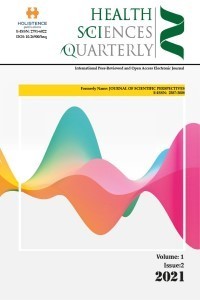Şule GÖKYILDIZ SÜRÜCÜ, Dilek BİLGİÇ, Gülseren DAĞLAR, Semiha AYDIN ÖZKAN, Zekiye TURAN, Handan GÜLER, Hülya DEMİRCİ, Sultan ALAN, Sema DERELİ YILMAZ, Ayten DİNÇ, Eylem TOKER, Hüsniye DİNÇ, Tuba UÇAR, Saadet Gonca MAVİ AYDOĞDU, Zekiye KARAÇAM, Selda YÖRÜK, Figen DIĞIN, Gözde GÖKÇE İŞBİR, Hasan Hüseyi
The relationship between midwifery students’ acceptance of violence between couples and level of aggression: A multicentered study
The study was aimed to identify the relationship between acceptance of violence between couples and level of aggression among first and fourth year midwifery students in various universities in Turkey. This is a cross-sectional descriptive study. Personal Information Form, Acceptance of Couple Violence Scale and Aggression Scale were used to collect the data. In the study, the number of the first year students was 1843, and the number of the fourth year students was 1337. There was a weak positive relationship between Aggression Scale and Acceptance of Couple Violence Scale. Acceptance of violence between couples was found to increase with the increase in aggression level. Adolescents’ views on aggression between boys and girls are of great importance to provide an opportunity for early intervention and to maintain healthy relationships. It may be suggested that midwifery departments providing health education include these subjects in their curriculum.
Keywords:
Dating, violence, aggression, flirt, youth,
___
- ASLAN, D., VEFIKULUCAY, D., ZEYNELOGLU, S., et al. 2008, The Study of Determine to Exposure Flirt Violence, Apply Flirt Violence and Views About This Subject of 1st and 4th Year Students in Two Nursing School in Ankara. Technical Report on the Public Health Foundation and Hacettepe University Women's Problems Research and Application Center, Ankara. (In Turkish)
- BLACK, B.M., CHIDO, L.M., PREBLE, K.M., et al. 2015, Violence exposure and teen dating violence among African American youth. Journal of Interpersonal Violence, 30(12):2174-2195. Doi: 10.1177/0886260514552271
- BROWN, L.K., PUSTER, K.L., VAZQUEZ, E.A., et al. 2007, Screening practices for adolescent dating violence. Journal of Interpersonel Violence, 22(4):456-64.
- CAN. S. 2002, The reliability and validity of aggression questionnaire in Turkish population. Speciality Thesis, Gulhane Military Medical Academy, Istanbul. (In Turkish)
- CAUFFMAN, E., FELDMAN, S.S., JENSEN, L.A., et al. 2000, The (un)acceptability of violence against peers and dates. Journal of Adolescent Research, 15(6):652-673.
- CHIUNG-TAO SHEN, A., YU-LUNG CHIU, M., and GAO, J., 2012, Predictors of dating violence among Chinese adolescents: The Role of Gender-Role Beliefs and Justification of Violence. Journal of Interpersonal Violence, 27(6):1066-1089.
- CORNELIUS, T.L., SULLIVAN, K.T., WYNGARDEN, N., et al. 2009, Participation in prevention programs for dating violence beliefs about relationship violence and intention to participate. Journal of Interpersonal Violence, 24(6):1057-1078.
- EARNEST, A.A., and BRADY, S.S., 2016, Dating violence victimization among high school students in minnesota: associations with family violence, unsafe schools, and resources for support. Journal of Interpersonal Violence, 31(3):383-406. Doi: 10.1177/0886260514555863
- FOSHEE, V.A., ENNETT, S.T., BAUMAN, K.E., et al. 2005, The association between family violence and adolescent dating violence onset does it vary by race, socioeconomic status, and family structure? Journal of Early Adolescence, 25(3):317-344. Doi: 10.1177/0272431605277307
- GOVER, A.R., KAUKINEN, C., and KATHLEEN, A., 2008, The relationship between violence in the family of origin and dating violence among college students. Journal of Interpersonal Violence, 23(12):1667-1693.
- HARNED, M.S., 2002, A multivariate analysis of risk markers for dating violence victimization. Journal of Interpersonal Violence, 17(11):1179-1197. Doi: 10.1177/088626002237401
- JOSEPHSON, W.L., and PROULX, J.B., 2008, violence in young adolescents’relationships a path model. Journal of Interpersonal Violence, 23(2):189-208.
- KEPIR-SAVOLY, D.D., ULAS, O., and DEMIRTAS-ZORBAZ, S., 2014, Factors that influence level of couple violence acceptance. Turkish Psychological Counseling and Guidance Journal, 5(42):173-183. (In Turkish)
- KILINCER, A.S., and TUZGOL DOS, M., 2014, Perceived abuse in romantic relationships among university students. Journal of Turkish Psychological Counseling and Guidance, 5(42):160-172. (In Turkish)
- LAPORTE, L., JIANG, D. and PEPLER, D.J., 2009, The relationship between adolescents’ experience of family violence and dating violence. Youth & Society, 43(1):3-27. Doi: 10.1177/0044118X09336631
- LUTHRA, R., and GIDYCZ, C.A., 2006, Dating violence among college men and women evaluation of a theoretical model. Journal of Interpersonal Violence, 21(6):717-731.
- MARQUART, B., NANNINI, D., and EDWARDS, R., 2007, Prevalence of dating violence and victimization: regional and gender difference. Adolescence, 42:645–57.
- MARTSOLF, D.S., DRAUCKER, C.B., and STEPHENSON, P.L., 2012, Patterns of dating violence across adolescence. Qualitative Health Research 22(9):1271-1283.
- OZDAMAR, K., 2003, Biostatistic with SPSS. (5th ed). Kaan Publishing, Eskisehir. (In Turkish)
- PRADUBMOOK SHERER, P., 2011, Youth Attitudes toward Dating Violence in Thailand. International Journal of Offender Therapy and Comparative Criminology, 55(2):182–206. DOI: 10.1177/0306624X09360659
- SEZER, O., 2008, The adaptation of acceptance of couple violence scale into Turkish: validity and reliability studies. Journal of the Faculty of Education, 9(16):1-15. (In Turkish)
- ULUOCAK, S., GOKULU, G., and BILIR, O., 2014, A strategic starting point for the elimination of violence against women: Intimate partner violence. International Journal of Human Sciences, 11(2):362-387. doi: 10.14687/ijhs.v11i2.2942. (In Turkish)
- World Health Organization 2002, World Report on Violence and Health
- Başlangıç: 2017
- Yayıncı: Holistence Publications
Sayıdaki Diğer Makaleler
Sevim BAYSAK, Ebru KARAGÜN, Havva Hilal AYVAZ
Abdülkadir BİLİR, Tolga ERTEKİN, Ozan TURAMANLAR, Hilal GÜZEL, Emre ATAY
Mehtap PEKESEN, Elif KOCAKAPLAN, Mehtap KACAR, Elif VATANOGLU
Beyza GENÇ ÇETİN, Taşkın ŞENTÜRK, Neriman AYDIN
Şule GÖKYILDIZ SÜRÜCÜ, Dilek BİLGİÇ, Gülseren DAĞLAR, Semiha AYDIN ÖZKAN, Zekiye TURAN, Handan GÜLER, Hülya DEMİRCİ, Sultan ALAN, Sema DERELİ YILMAZ, Ayten DİNÇ, Eylem TOKER, Hüsniye DİNÇ, Tuba UÇAR, Saadet Gonca MAVİ AYDOĞDU, Zekiye KARAÇAM, Selda YÖRÜK, Figen DIĞIN, Gözde GÖKÇE İŞBİR, Hasan Hüseyi
